The BlackBerry PlayBook Review
by Anand Lal Shimpi on April 13, 2011 9:00 PM EST- Posted in
- Tablets
- Smartphones
- RIM
- BlackBerry
- PlayBook
- Mobile
I suppose it's fitting that I should be the one to write our PlayBook review. Before Android and the iPhone, there were two mobile platforms/devices that I was hugely fond of: the Palm V and my BlackBerry. In fact, it wasn't until the iPhone that I finally let go of my last BlackBerry - moving on from the email era into the smartphone age.
Today's BlackBerry is of course very different than the devices I used in college. And the PlayBook is unlike anything RIM has ever done.
I don't believe any tablet maker has perfected the formula just yet. I made that abundantly clear in our review of the iPad 2. While you can't argue that Apple is the forerunner in the smartphone based tablet space, over the long term I still believe this is anyone's game. Remember, the leaders in the early days of the PC industry weren't the ones who ultimately dominated the mature market.
What follows is our review of RIM's first attempt at building a tablet. The PlayBook is far from perfect, but there's a foundation here that can be built upon if RIM has a good roadmap and good execution. And if you're a BlackBerry user, there's a lot of synergy to exploit.
| BlackBerry PlayBook Pricing Comparison | |||||
| 16GB | 32GB | 64GB | |||
| WiFi | $499 | $599 | $699 | ||
Let's get to it.
The Hardware
If we view the primary difference between the first and second generation of smartphone based tablets as being ergonomics and performance, the PlayBook falls squarely in between the two.
At 10mm thick the PlayBook (7-inch display) is more iPad 1 (9.7-inch) or Xoom (10.1-inch) than iPad 2 or Galaxy Tab 8.9, but what RIM lacks in thinness it makes up for in overall size. The PlayBook is an almost-pocketable tablet. Bigger than the 5-inch Streak and even bigger than the 7-inch Galaxy Tab, the PlayBook isn't a pain to port around. The PlayBook is small enough to snugly fit inside the outer pocket of a long men's winter coat or a lady's purse. While I definitely don't carry my iPad everywhere, if it were more functional I could see carrying the PlayBook with me more often than any other tablet.
The PlayBook's styling is modest, even for BlackBerry standards. The front has a single BlackBerry logo along the bottom bezel and a visible camera lens but that's it. Around back you've got RIM's logo, a larger lens for the rear-facing 5MP camera sensor and a sea of black.
The only buttons on the device are along the top of the PlayBook: power, volume down, pause/play and volume up. The power button is flush with the surface of the PlayBook's edge. You basically need a pointy finger nail (which I typically don't have) to press it easily and as a result the power button was pretty much useless to me. If you can manage to hit it the power button will lock the PlayBook, otherwise you'll have to leave the tablet idle until it automatically goes into standby. RIM tells me that final versions of the PlayBook will have this power button raised by 0.8mm, enough to make it easily clickable.
Press and hold the power button and you'll be greeted with a PC-like choice to either power off the PlayBook or restart it. I'm not sure how frequently RIM expects you to do the latter, but when testing it's a nice feature to have.
The volume up/down buttons work as expected, although the volume level itself doesn't seem to be very linear. There's a single 1/8" headphone jack up top, near a port for the PlayBook's microphone.
The PlayBook features a pair of pretty loud stereo speakers on the front of the device. Being used to the iPad's single speaker, the PlayBook's two speakers are nice.
Charging is always an issue on these USB devices. You can take Apple's approach and charge over USB, which unfortunately can take a while to fill up a tablet's battery. You also run into issues with older computers that don't support the USB Charging spec, resulting in charging-only-while-sleeping like the iPad. Then there's Motorola's approach with the Xoom where you don't charge over USB but have a dedicated port for an AC adapter. Charging times are significantly reduced but now you need to carry around an extra adapter with you wherever you go. RIM arrived at what's quite possibly the best solution. The PlayBook will charge over USB and it also features a higher amperage quick-charge port for use with some of its accessories.
The battery is of course not removable and there's no USB port or SD card reader.
The Form Factor
The PlayBook is only slightly larger than Samsung's 7-inch Galaxy Tab and maintains the same 7-inch screen size (albeit with a functional border around the screen). Given my complaints about current tablets not being incredibly portable compared to a smartphone, you'd think that I'd love the PlayBook's form factor. To be honest, for portability, I do.
| Tablet Specification Comparison | |||||
| Apple iPad 2 | BlackBerry PlayBook | Motorola Xoom | |||
| Dimensions | 241.2mm x 185.7mm x 8.8mm | 194mm x 130mm x 10mm | 249.1mm x 167.8mm x 12.9mm | ||
| Display | 9.7-inch 1024 x 768 | 7-inch 1024 x 600 | 10.1-inch 1280 x 800 | ||
| Weight | 601g (WiFi only) | 425g | 730g | ||
| Processor | 1GHz Apple A5 (2 x Cortex A9) | 1GHz TI OMAP 4430 (2 x Cortex A9) | 1GHz NVIDIA Tegra 2 (2 x Cortex A9) | ||
| Memory | 512MB | 1GB | 1GB | ||
| Storage | 16GB up to 64GB | 16GB up to 64GB | 32GB + microSD card | ||
| Pricing | $499 up to $829 | $499 up to $699 | $599 - $799 | ||
While I'm almost never tempted to bring the iPad with me when I'm going around town, the PlayBook is a far easier sell. It's almost pocketable (and actually pocketable if I'm wearing a big jacket) and isn't too heavy.
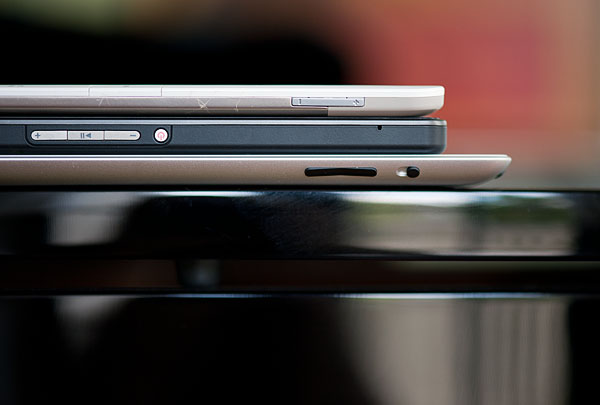
From top to bottom: Amazon Kindle 2, BlackBerry PlayBook, Apple iPad 2
Even when I'm not out and about, the PlayBook is quite usable as a content consumption device. In portrait mode fonts are a bit too small for me to read comfortably on the couch but in landscape it works well as a reddit browsing machine.
It's in the couch-lounging usage model that the PlayBook does fall short of the iPad or Xoom. But in terms of portability the PlayBook is clearly a much better balance of functionality and mobility. If you read between the lines you'll come to the same conclusion I have: neither the PlayBook nor the iPad is the perfect form factor for a tablet. Further more, I'm not sure there is a single perfect tablet form factor.
Apple tends to be a one-size-fits-all company when it comes to iOS. You want a smartphone? That'll be a 3.5-inch screen on an iPhone. Want a tablet? 9.7-inch iPad. It's interesting given how carefully Apple selected its four notebook sizes: 11, 13, 15 and 17-inches.
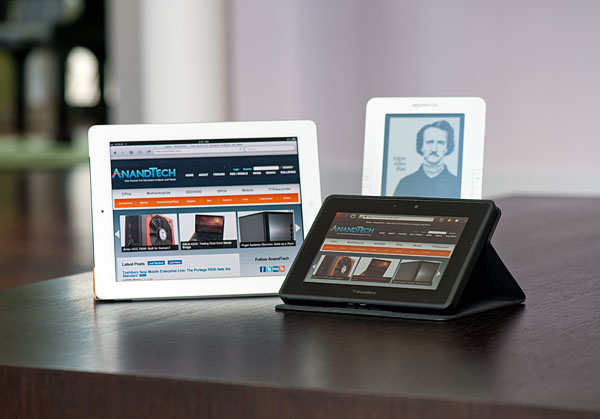
Clockwise: Apple iPad 2, Amazon Kindle 2, BlackBerry PlayBook in Convertible Case
Ultimately I don't think tablets will fall into the one-size-fits-all category. Instead I believe they're ultimately headed for some sort of a convergence with netbooks or notebooks. Today that's difficult to see because they lack a common hardware ISA, OS and even apps, but you don't have to look too far into the future to see those problems going away.
While I appreciate the PlayBook's portability and would definitely carry it around more than an iPad, it's not as nice to use laying back on a couch. The screen is too small to comfortably read in portrait mode and even in landscape things can get a bit cramped.
RIM's market research shows a clear preference for portability, hence the PlayBook's introductory 7-inch form factor. However RIM also pointed out that the BlackBerry comes in all shapes and sizes, indicating that the PlayBook would ultimately be available in different form factors as well. RIM also indicated that the 7-inch PlayBook may not be the smallest size offered either. Clearly RIM views the tablet market much like the notebook market: there will be ultraportables and there will be workhorses, with tons of choice in between. The 7-inch PlayBook is merely a starting point. Assuming RIM can fund the projects, we'll likely see both larger and smaller siblings in the future.



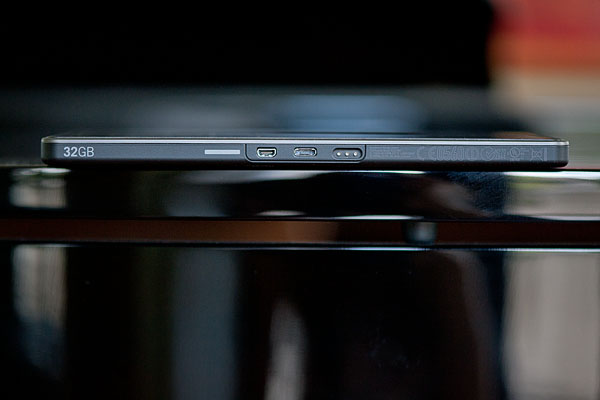
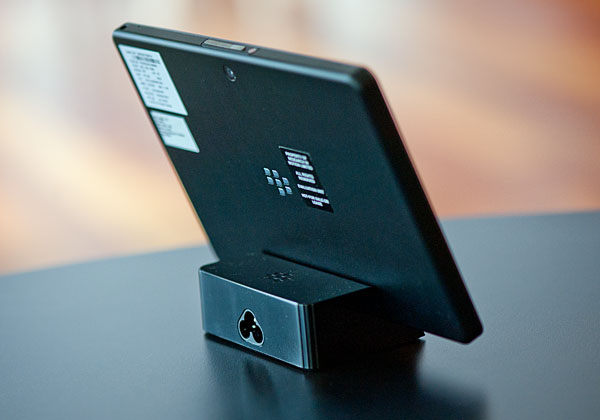
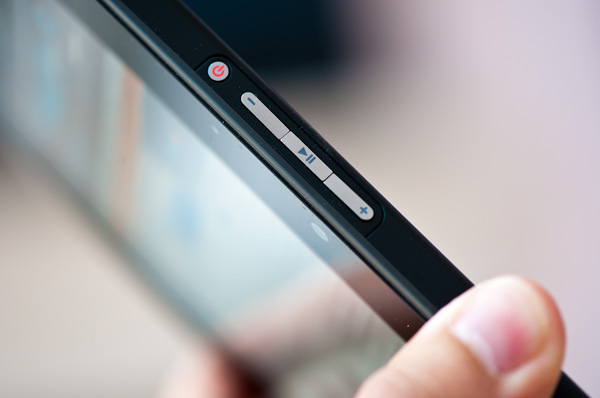
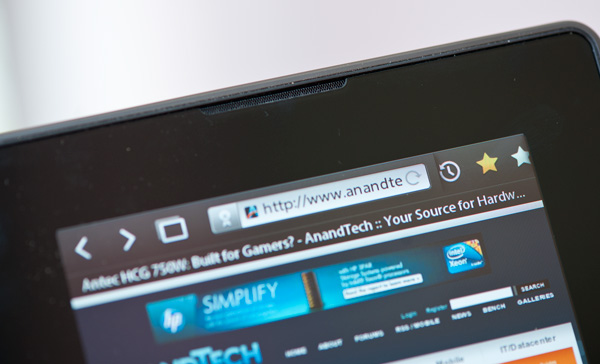








77 Comments
View All Comments
legoman666 - Wednesday, April 13, 2011 - link
No email client? Really? Is that a joke?Ethaniel - Wednesday, April 13, 2011 - link
For now it seems, but that's clearly a sample unit. All I keep reading is "needs tuning" and "needs optimization", ergo, it's not ready, and they're going to launch it anyway. Those updates will have to be lightning-fast. I don't want to pay 500 dollars to be a beta tester...SimKill - Wednesday, April 13, 2011 - link
I'm actually surprised. This is because my cousin in India said that his friend in Dubai already bought it and has it for quite some time. Do you think there might be a reason why they are purposely delaying the American release?melgross - Thursday, April 14, 2011 - link
Probably, someone is lying about it, or they've gotten some illegally obtainedRe
Reduction model much as what happened the Apple's iPhone 4.
It's first being released in N. america, according to RIM.
vol7ron - Friday, April 15, 2011 - link
Why does everyone want to price around Apple? The more I look at these devices, the more I'm likely to get the color-nook and put Droid on it. Surely the hardware would be lacking, but the functionality would still be ballpark.16GB for $500 is ridiculous. These base models need to be in the $250-300 range.
michael2k - Friday, April 15, 2011 - link
Um, the raw materials for the iPad is about $260, meaning you can't expect to buy a 16gb tablet from any manufacturer, especially one with less buying power than Apple, for much less than $400 or so.From the iPad 2:
Display is $127
Flash is about $66 for 32gb, $35 for 16gb
Case & Battery is about $60
Mobo+Camera is about $60
So for any 10" tablet the cost if they gave it away for free would be $282 or so. Your nook "cheaps out" by having a 7" screen, only 8gb storage, a slower CPU, no cameras, and a much smaller battery. It only gets 8 hours with wifi off, the iPad 2 gets 11 hours with wifi on!
In other words you're only paying $180 worth of HW in the Nook, while the iPad gets you two 1GHz cores vs a 800MHz core, 11h of battery vs less than 8 hours, 10" and 1024x768 vs 7"@1024x600, 16gb vs 8gb, and of course, no guarantee of OS updates. You're complaint is ridiculous, actually, since almost no other manufacturer has been able to beat Apple on price yet except the Acer Iconia.
quiksilvr - Friday, April 15, 2011 - link
As much as I despise Apple, I have to agree to an extent. Yes that price is quite hefty, but if Apple didn't have it's cult following, it would have easily been on sale for $399. But thanks to idiot consumers, they can bump it up a Benjamin.michael2k - Friday, April 15, 2011 - link
And no one else can order in vast enough quantities to hit the $399 price.mcnabney - Friday, April 15, 2011 - link
I am starting to doubt the iSupply numbers you quoted.They price the very nice 9.7" IPS screen that Apple uses at $129 while the clearly inferior non-IPS screen the XOOM uses at $140. Their memory prices are also highly suspect, clinging to $2/GB for what are still really small drives compared where higher performing SSDs already are. I would guess that NAND prices for tablets are under $1/GB wholesale and in quantity.
michael2k - Friday, April 15, 2011 - link
Apple orders literally 2m 9.7" IPS screens a month, probably 40m this year alone. That gives them bulk purchasing power no one else has except the manufacturer of said screens.Motorola has to pay market prices, while Apple can literally buy an entire factory's output. http://www.isuppli.com/Display-Materials-and-Syste...
It doesn't help that the Japanese earthquake halted LCD production at major plants, either!
As for SSD chips, Apple is paying a premium to get density. The low end iPad has only a single SSD 16GB chip. The mid range iPad has one or two, and the high end has two 32GB chips. As soon as prices are good or capacity is good, I'm sure Apple will use a single 32gb chip on the low end, two 32gb chips for the middle, and 2 64gb chips on the high end.